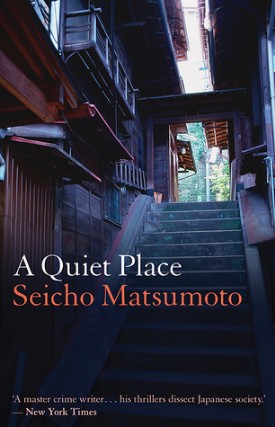
Seicho Matsumoto
Originally Published 1975
A Quiet Place is one of those novels that presents a particular challenge to review without mentioning at least a few spoilers. This is because there is an event that takes place a significant way into the novel which transforms the narrative.
This novel is the first I have read by Matsumoto, an author who was one of the most successful and important figures in Japanese crime fiction. This is a work from later in his career and while I have seen it described as a thriller, that would be a slightly misleading way to characterize a book that contains very little action and little in the way of suspense. It certainly doesn’t read that way. Instead I would suggest it is better regarded as a character study with mysterious elements and some of the form of a detective story.
The novel concerns Tsuneo Asai, a middle-ranking but respected official in the Ministry of Agriculture. He works hard to ingratiate himself with his superiors, knowing that they will likely be with him a short time but hoping that his efforts may lead to some future promotion. He is on a trip with them attending a dinner when he receives a telephone call from his wife’s sister. She informs him that his wife who was only thirty years old died some five hours earlier of a heart attack. He cuts his trip short, returning home to make the funeral arrangements.
As he learns more about the circumstances of his wife’s death he becomes increasingly confused. Not by the cause of death, as he knew she suffered from a serious heart condition, but rather from the location in which it occurred. She died in a boutique shop in a neighborhood he would hardly expect her to visit. He decides to pay a visit to the shopkeeper to offer a payment for the inconvenience his wife’s death caused her business but is confused by the shopkeeper’s demeanor and some of her responses, leading him to have even more questions about her death.
What follows adheres to many of the beats of the detective novel with the husband working to piece together what happened. He interviews some witnesses, tries to get a sense of the location and comes up with a theory. There is little surprising in the content of those investigations, rather the interest comes from the way that this investigation will affect Asai. I should also say at this point that I appreciated that the author has this story take place slowly over a number of months, emphasizing Asai is not a professional investigator and is having to work around the restrictions of his work calendar.
This sort of internalized, psychological story can be only as interesting as its protagonist and here I feel that Matsumoto meets with mixed success. Asai shows some intriguing and credible contradictions within his personality and I can see that there seems to be some satirical notes struck in his characterization yet the character’s reserved and calculating personality means he rarely dominates the narrative, especially in those early chapters.
While he has suffered a loss, the reader is unlikely to feel much sympathy for him given the way in which he responds. For instance, in the immediate aftermath of getting the news his first thought is how to convey the information to his colleagues and ensure his superior continues to receive good hospitality on their trip. As the narrative develops however I think depth is added to that characterization, building up to that moment I referenced where the novel takes on a different tone and style.
I do not want to give the impression that this is an abrupt or unexpected change – I would argue that it is actually rather a natural and organic development from the seeds laid in those early chapters. For me this shift worked nicely because it built upon what had come before and I think what follows is very well plotted and ultimately very satisfying. On the other hand, I could easily see it frustrating readers who come to this hoping for a more traditional whodunit or thriller structure due to its unorthodox structure and sense of pacing.
This puts me in a somewhat difficult position when it comes to recommending it as while I think it is ultimately a very successful novel that contains some wonderful character and thematic moments, it is perhaps less compelling as an example of the mystery genre. After all, for much of its duration the book is really not that mysterious and certainly the explanation for the wife’s death is likely to disappoint most readers expecting a more traditional detective story structure. Indeed, for much of the novel it is not even clear if a crime has taken place.
For those prepared to endure an extremely leisurely pacing for much of the novel, I do think there are some strong rewards both in the way Matsumoto builds to a striking ending and also the fascinating depictions of Japanese social interaction. Set your expectations accordingly and I think you will find it to be an interesting, characterful read.




Leave a comment